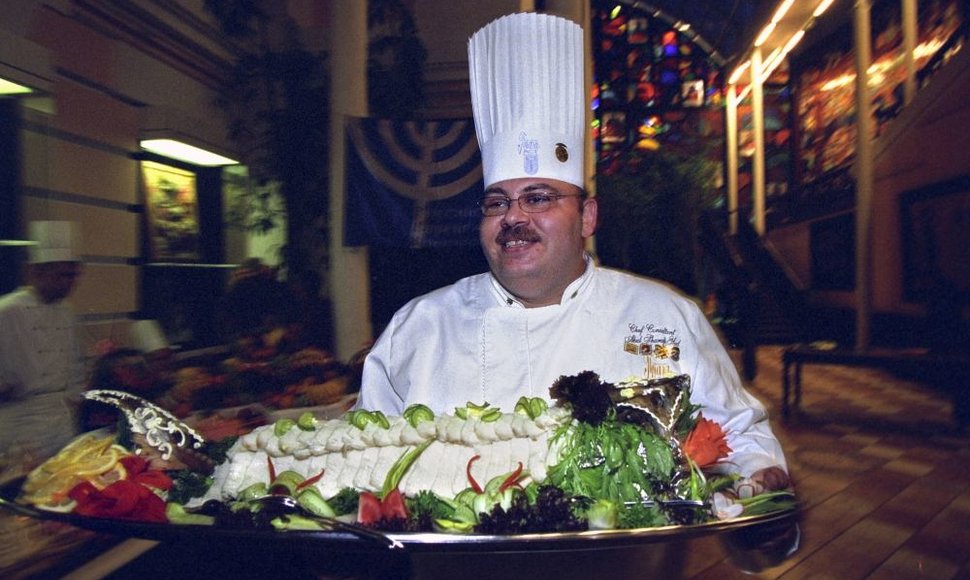Now that we’ve all grown up, I’m not sure what was so funny. Maybe that’s the joy of childhood — you laugh at everything. Recently I’ve become fascinated by Sephardic cooking. Not only is its evolution fascinating, the combinations are unique.
What is the difference between Ashkenazi and Sephardic cuisine?
According to Claudia Roden in “The Book of Jewish Food,” the Ashkenazi tradition evolved in small contained areas in Eastern Europe, mostly in Russia, Poland and Germany, from Jews whose life had been filled with poverty and insecurity. This tradition of “poor food” was made with local ingredients and featured cheap cuts of meat and plain, plentiful vegetables such as potatoes, carrots and onions. It was insular and specific and left little room for interpretation when it was presented to Jews in the United States, Canada, South America, South Africa, Palestine, and the Western European countries of Belgium, England, France and Holland.
In contrast, the Sephardic tradition evolved when Jews were expelled from Spain in 1492 and migrated to areas as diverse as North and South Africa, the Middle East, India, and later to the Mediterranean countries of Spain, Italy, Portugal, Bulgaria, Greece and Turkey. There, they embraced the customs and traditions of their new homes, and incorporated not only the cuisines of those areas, but also the varied ingredients and cooking styles.
Sephardic cuisine is eclectic and regional, encompassing styles as diverse as Moroccan, Tunisian, Algerian and Libyan, the cuisines of Syria, Lebanon, Iraq and Iran, and the Mediterranean. It combines sweet with sour, adds nuts and fruits to meats and salads, and encourages experimentation with unusual fresh fruits and vegetables.
Because the Sephardim incorporated cooking traditions from both the economically and culturally deprived peoples in Islamic lands, as well as the aristocratic elite from Baghdad, Spain and the Ottoman world, some of the recipes are primitive and peasant-like, while others are refined and sophisticated. But even the “depressed” countries offered dishes requiring elaborate procedures, delicate flavorings and appealing presentations.
Passover: Ashkenazi and Sephardi style
Although we are one people, we have two cuisines and nowhere is it more significant than at Passover, when we commemorate the Exodus out of Egypt — from slavery to freedom — and the birth of the Jewish nation.
The first night of Passover begins at sundown on Thursday, when families and friends gather for the first Seder to retell the story.
Because we have always defined ourselves by our food, we punctuate every emotion our ancestors experienced by partaking of the symbolic foods, which are displayed on the Seder plate in the center of the Seder table. We bite into herbs so bitter our eyes sting and we all but choke — a visceral reminder of the harshness of slavery. We dip parsley sprigs into salt water to simulate their tears. We mindlessly chew tasteless matzo, the bread of affliction, and wash it down with four cups of wine, each linked to an aspect of our liberation.
We smile with glee, anticipating our favorite Passover treat: the fruit, nut, honey and wine mixture Charoset, which symbolizes the brick and mortar the Jewish slaves used to build pharaoh’s pyramids. We pile maror (bitter herbs) and Charoset between two pieces of matzo to make the Hillel sandwich which denounces the bitterness of slavery and celebrates the sweetness of salvation.
It is in honor of that transformation that one of our most interesting food traditions was born. As the story goes, Moses was chosen to liberate the Jewish people. He pleaded with the pharaoh to let his people go, but the cruel leader was intransigent. So Moses ordered the Israelites to flee Egypt with such speed that the bread they hurriedly made to sustain themselves during their journey had no time to rise. To remind us of their deprivation and misery, during Passover we eat only unleavened bread — matzo, the bread of affliction.
The Torah reads, “For seven days shall there be no leaven found in your home.” So families make a great production of purging their homes of foods considered leaven (chametz). Sephardim “sell” the forbidden chametz to their non-Jewish neighbors. At the end of Passover they “buy” it back.
Fermenting agents such as yeast are banned, as are the five types of grain — wheat, barley, rye, oats and spelt. The Ashkenazi also forbid rice, dried corn, dried beans, peas and lentils, although the Sephardim allow them.
Because of the demands of cooking without grain or leaven, a whole range of ingredients are used in nontraditional ways. Instead of stuffing poultry and meat with breadcrumbs, we use matzo farfel (small pasta), mashed potatoes, fruits, vegetables, nuts and seeds. While Ashkenazim don’t use grains, Sephardim use cracked wheat, ground rice and a variety of other cereal seeds.
Pastries are made from ground almonds, walnuts and hazelnuts, potato flour, potato starch, matzo meal, and matzo cake flour. The favorite cookie at Passover is macaroons, made of coconut, ground almonds, sugar and egg white. Fritters are made from matzo meal. And pancakes are replaced with matzo brie, using sheets of matzo soaked in beaten eggs.
Sephardim in Morocco barbecue during the holiday to remind us that our people left Egypt in such a hurry, they grilled foods over a wood fire.












